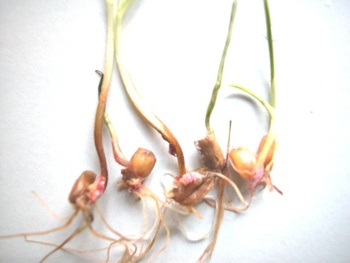Diseases
Fusarium root rot of wheat .
Taxonomic position.
Fusarium root rot of wheat is caused by numerous species, most commonly by F. oxysporum Schlectend.: Fr and F. solani (Mart.) Sacc. However, F. avenaceum Cook, F. verticilliodes e J. Sheld. (sexual stage: G. moniliformis), F. subglutinans (sexual stage: G. subglutinans) (Wollenweb. & Reinking) P.E. Nelson, T.A. Tousson & Marassas, F. acuminatum Ellis & Verh., F. equiseti (Corda) Sacc. also cause root rot in plants. Class Deuteromycetes, order Moniliales, family Tuberculariaceae, genus Fusarium.Biological group.
Hemibiotrophic parasites. Symptoms generally include dark brown to black, decaying or completely rotted roots; deceleration of seedling growth, chlorosis of plants, reduced root growth and decay of the crown area. A dark or brown decay often occurs in the sub-crown internode between the crown and second or third node.Morphology and biology.
All Fusarium species have one taxonomic feature in common, i.e., the production of distinctly curved macroconidii (20 to 70 microns), usually with a foot-shaped basal cell and different number of septae. Some species produce microconidii (to 10 microns). The complex features, when combined with other primary and secondary characters of fungi, compose the basis for the classical approach to the Fusarium taxonomy. Abundant spore production occurs on diseased tissue. Spores are spread by wind, water, under soil treatment and through infected seeds. Thick-walled chlamydospores of various species of Fusarium are about 20 microns in diameter. The chlamydospores can persist in soil for many years. The fungus over-winters also by mycelii in infected plant debris and seeds.Distribution.
Representatives of the Fusarium fungi occur in all wheat production regions as a component of common root rot. In Russia, Fusarium root rot of wheat is a typical disease in the European part. In Asian regions Fusarium species are partial contributors to the common root rot complex caused primarily by Cochliobolus sativus.Ecology.
Polyphagous Fusarium fungi damage different parts of various plants. The common root rot is one of the most harmful diseases of wheat, barley, oats, and other crops; as well as wild plants. This means that the pathogen can permanently survive in the field. Fusarium spores are disseminated by animals, man, and splashing water. Fusarium root rot fungi may be either primary or secondary pathogens or saprophytes colonizing tissues after another root rot pathogen has already appeared. Seedlings become infected following germination and further infections occur throughout the vegetation season. The fungus enters the roots and infects cortical tissues and the xylem. Sometimes seedlings become infected by fungi preserved in the soil, on crop residues, or on the seed coat. The spores germinate, stimulated by nutrients exuded by germinating seeds and root tips. Then the fungus penetrates plant tissue. The damage usually increases under environmental conditions that stress plants. These conditions include deep planting, heavy soils, cool temperatures, high or low fertility, and flooding.Economic significance.
Seedlings may die before or soon after emergence even though they are only weakly attacked. If seedling infection by Fusarium is mild and the seedling survives, the plant can get common root rot later in the season. Secondary infections by other soil-borne pathogens may increase the initial disease. Common root rot can cause significant yield loss by reducing tillers, kernel weight, and number of seeds per head. The losses in yield from Fusarium root rot reach 5 to 30%. A successful start to a cereal crop requires healthy seeds. Seed treatments by fungicides are an excellent tool in reducing the risk of seed and seedling diseases. Rotation with non-cereal crops and control of grassy weeds reduce inoculum levels. Conditions that promote plant health and growth reduce losses associated with Fusarium root rot. The best control measure is to sow seeds in warm, well-prepared soil capable of supporting rapid plant growth. The application of phosphorus and potassium fertilizers encourages vigorous roots and enables plants to resist infection. The use of resistant varieties can overcome disease development.Reference citations:
Root rot of spring wheat. Tupenevich S.M. (Ed.). Leningrad, 1974, 1-64 (in Russian).Recommendation for protection of cereal crops against root rot. Hohrjkov M.K. et al., (Ed.). Agricultural department of the USSR, Moscow, 1978, 1-28 (in Russian).
Babayants L.T., Klechkovskaya T.A. Estimation of the resistance of wheat to Fusarium root rot. The Recommendation, 1988, 1-20 (in Russian).
Benken A.A., Khatzkevich L.K., Nesterov A.N. The problem of root rot in cereals. Mikologiya i fitopatologiya, 1987, 21, 6, 566- 573 (in Russian).
Practical instruction for diagnostic of fungal disease on cereal crops growing in the North Caucasus. Krasnodar, 1990, 1-29 (in Russian).
Recommendation for protection of winter wheat against complex of harmful objects in the Belgorod Region. Levitin M.M. at all. (Ed.). St.Petersburg, 1998, 1-4 (in Russian).
© Gagkaeva T.Yu.


